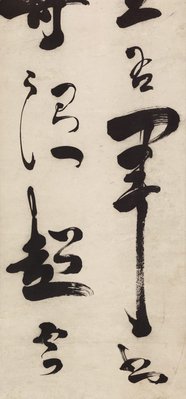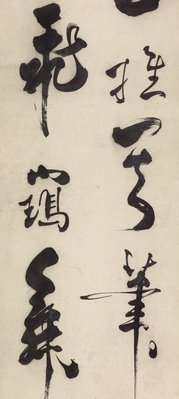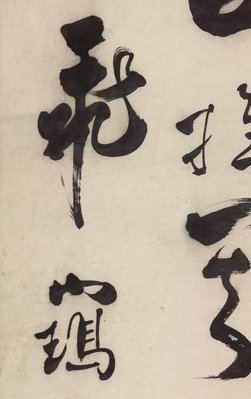






-
Details
- Alternative title
- (Calligraphy scrolls)
- Place where the work was made
-
China
- Period
- Qing dynasty 1644 - 1911 → China
- Date
- 18th century
- Media categories
- Scroll , Painting , Calligraphy
- Materials used
- four hanging scrolls; ink on paper
- Dimensions
-
210.3 x 140.0 cm overall
:
a - scroll, 210.3 x 38 cm, scroll
b - scroll, 210.3 x 32 cm, scroll
c - scroll, 210.3 x 32 cm, scroll
d - scroll, 210.3 x 38 cm, scroll
a - scroll, 128.4 x 30.5 cm, image
b - scroll, 128.4 x 30.5 cm, image
- Signature & date
Signed., l.l. [of the last scroll] in Chinese, inscribed in black ink, " signed Zhu Nan."
- Credit
- Edward and Goldie Sternberg Chinese art purchase fund 1992
- Location
- Not on display
- Accession number
- 59.1992.a-d
- Copyright
- Artist information
-
ZHU Nan
Works in the collection
- Share
-
-
About
Zhu Nan was a noted and recorded calligrapher in 18th century Qing China. This set of scrolls is executed in cursive script, with all the quiet drama, spontaneity and emotive variation that are characteristic of the style. They read (from right to left):
'The calligraphy of Wang Youjing (Wang Xizhi) of the Jin dynasty is unique and powerful, superior to any before and after him./ His brushwork is like a flying dragon and dancing phoenix, and resembles astonishing thunder and falling rocks./ It contains the vitality of expression, the spirit of the mountain and forest, and the beauty of the pavilion. Everything about it is so admirable./ His writing is so unique in history, it is treated as a great treasure. I wrote this to Ting Gui, my kindest brother, for your instruction [signed Zhu Nan].'
The phrase of 'Long Fei FengWu', flying dragon and dancing phoenix, was first used by famous Song Dynasty poet Su Shi(1037-1101). It is often used in Chinese to describe lively and vigorous flourishes in calligraphy.
The Chinese character for 'dragon' has evolved from oracle bones and bronze inscriptions to the two types of modern day writing (the simplified style or the more complicated style). Calligraphers throughout history also created their own styles when writing the character.
Asian Art Department, AGNSW, January 2012
-
Places
Where the work was made
China
-
Exhibition history
Shown in 5 exhibitions
Great gifts, great patrons, Art Gallery of New South Wales, Sydney, 17 Aug 1994–19 Oct 1994
Art of the brush, Art Gallery of New South Wales, Sydney, 23 Sep 1995–12 Nov 1995
Dragon (2012), Art Gallery of New South Wales, Sydney, 18 Jan 2012–06 May 2012
The connoisseur and the philanthropist: 30 years of the Sternberg Collection of Chinese Art, Art Gallery of New South Wales, Sydney, 31 Jan 2014–27 Apr 2014
Beyond Words: Calligraphic Traditions of Asia, Art Gallery of New South Wales, Sydney, 27 Aug 2016–30 Apr 2017
-
Bibliography
Referenced in 3 publications
-
Yin Cao, The Connoisseur and the Philanthropist: 30 years of the Sternberg Collection, 'Chinese Art', pg. 12-23, Sydney, 31 Jan 2014, 20 (colour illus.).
-
Jackie Menzies, Art of the Brush - Chinese & Japanese painting calligraphy, Sydney, 1995, 5 (illus.), 6.
-
Jackie Menzies (Editor), The Asian Collections Art Gallery of New South Wales, 'Landscape Painting', Sydney, 2003, 157 (colour illus.).
-
